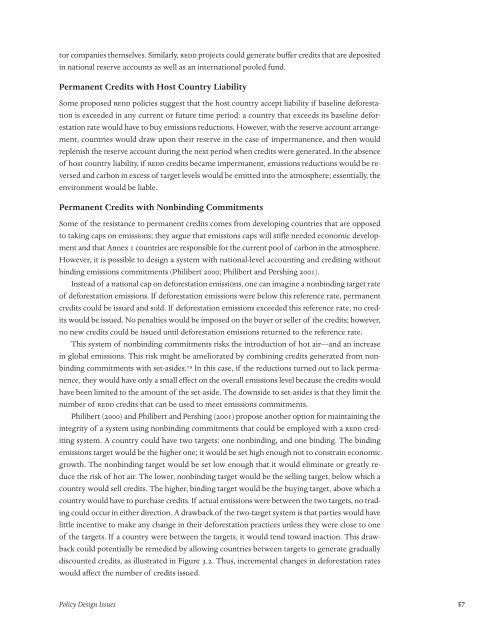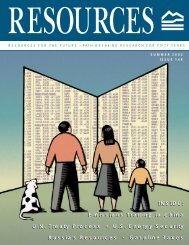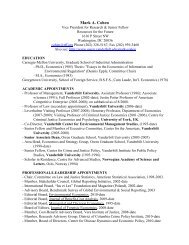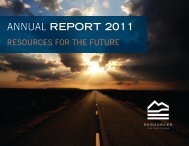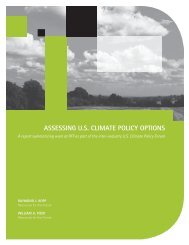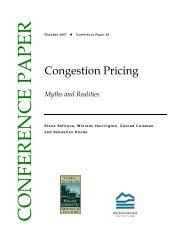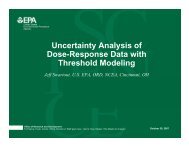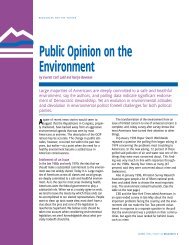Policies to Reduce Emissions from Deforestation and Degradation ...
Policies to Reduce Emissions from Deforestation and Degradation ...
Policies to Reduce Emissions from Deforestation and Degradation ...
Create successful ePaper yourself
Turn your PDF publications into a flip-book with our unique Google optimized e-Paper software.
<strong>to</strong>r companies themselves. Similarly, REDD projects could generate buffer credits that are deposited<br />
in national reserve accounts as well as an international pooled fund.<br />
Permanent Credits with Host Country Liability<br />
Some proposed REDD policies suggest that the host country accept liability if baseline deforestation<br />
is exceeded in any current or future time period: a country that exceeds its baseline deforestation<br />
rate would have <strong>to</strong> buy emissions reductions. However, with the reserve account arrangement,<br />
countries would draw upon their reserve in the case of impermanence, <strong>and</strong> then would<br />
replenish the reserve account during the next period when credits were generated. In the absence<br />
of host country liability, if REDD credits became impermanent, emissions reductions would be reversed<br />
<strong>and</strong> carbon in excess of target levels would be emitted in<strong>to</strong> the atmosphere; essentially, the<br />
environment would be liable.<br />
Permanent Credits with Nonbinding Commitments<br />
Some of the resistance <strong>to</strong> permanent credits comes <strong>from</strong> developing countries that are opposed<br />
<strong>to</strong> taking caps on emissions; they argue that emissions caps will stifle needed economic development<br />
<strong>and</strong> that Annex 1 countries are responsible for the current pool of carbon in the atmosphere.<br />
However, it is possible <strong>to</strong> design a system with national-level accounting <strong>and</strong> crediting without<br />
binding emissions commitments (Philibert 2000; Philibert <strong>and</strong> Pershing 2001).<br />
Instead of a national cap on deforestation emissions, one can imagine a nonbinding target rate<br />
of deforestation emissions. If deforestation emissions were below this reference rate, permanent<br />
credits could be issued <strong>and</strong> sold. If deforestation emissions exceeded this reference rate, no credits<br />
would be issued. No penalties would be imposed on the buyer or seller of the credits; however,<br />
no new credits could be issued until deforestation emissions returned <strong>to</strong> the reference rate.<br />
This system of nonbinding commitments risks the introduction of hot air—<strong>and</strong> an increase<br />
in global emissions. This risk might be ameliorated by combining credits generated <strong>from</strong> nonbinding<br />
commitments with set-asides. 15 In this case, if the reductions turned out <strong>to</strong> lack permanence,<br />
they would have only a small effect on the overall emissions level because the credits would<br />
have been limited <strong>to</strong> the amount of the set-aside. The downside <strong>to</strong> set-asides is that they limit the<br />
number of REDD credits that can be used <strong>to</strong> meet emissions commitments.<br />
Philibert (2000) <strong>and</strong> Philibert <strong>and</strong> Pershing (2001) propose another option for maintaining the<br />
integrity of a system using nonbinding commitments that could be employed with a REDD crediting<br />
system. A country could have two targets: one nonbinding, <strong>and</strong> one binding. The binding<br />
emissions target would be the higher one; it would be set high enough not <strong>to</strong> constrain economic<br />
growth. The nonbinding target would be set low enough that it would eliminate or greatly reduce<br />
the risk of hot air. The lower, nonbinding target would be the selling target, below which a<br />
country would sell credits. The higher, binding target would be the buying target, above which a<br />
country would have <strong>to</strong> purchase credits. If actual emissions were between the two targets, no trading<br />
could occur in either direction. A drawback of the two-target system is that parties would have<br />
little incentive <strong>to</strong> make any change in their deforestation practices unless they were close <strong>to</strong> one<br />
of the targets. If a country were between the targets, it would tend <strong>to</strong>ward inaction. This drawback<br />
could potentially be remedied by allowing countries between targets <strong>to</strong> generate gradually<br />
discounted credits, as illustrated in Figure 3.2. Thus, incremental changes in deforestation rates<br />
would affect the number of credits issued.<br />
Policy Design Issues 5


